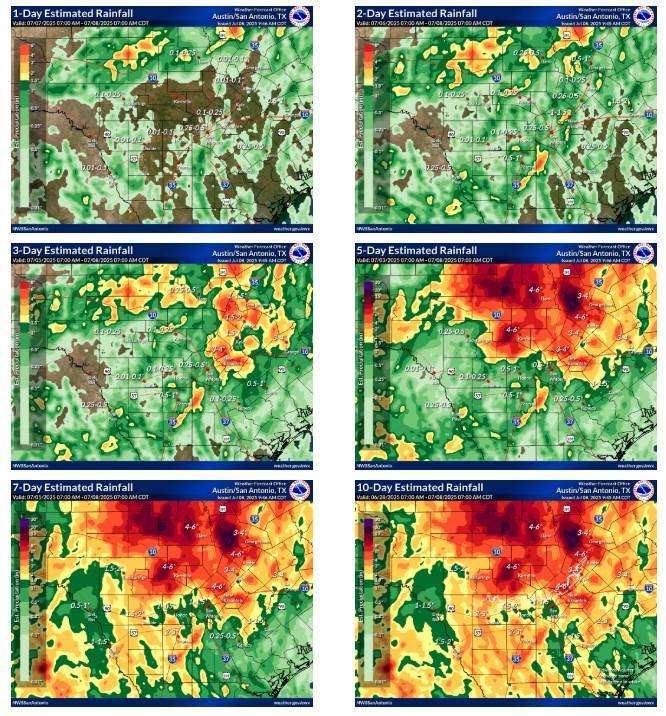The heavy loss of life in the central Texas Hill Country flash floods, when months worth of rain fell in the space of a few hours, highlights the dangers of this major hazard and the challenges in ensuring that early warnings reach those who need them.
More than 100 people were confirmed dead and dozens more missing after the floods, many of them young children at vacation camps. WMO sends its deep condolences to everyone affected.
Flash floods are among the world's deadliest natural hazards with more than 5 000 lives lost annually. Accounting for approximately 85% of flooding cases, flash floods also have the highest mortality rate among different classes of flooding, including riverine and coastal. They are therefore one of the key priorities of the Early Warnings for All initiative.
A flash flood is defined as a sudden, high-intensity flood event where the time between the triggering event (typically intense rainfall) and the onset of flooding is within a few hours. These events are characterized by rapid water level rise, high peak discharge, and often devastating impacts on infrastructure and communities, especially in urban and mountainous areas - as was the case with Texas.
Unlike slow-onset river floods, flash floods leave very limited time for reaction, making accurate short-term forecasting and community preparedness essential. That is why WMO emphasizes both technological innovation and training of hydrometeorological services in forecasting, early warning dissemination, and risk communication.
The US National Weather Service issued advance a flash flood watch for Kerr County more than 12 hours in advance. This was upgraded to a flash flood warning about three hours ahead of time, culminating in a flash flood emergency, which was disseminated by Weather Radio, emergency management systems, and TV/radio.
But one of the challenges was that the final warnings came as people were sleeping and there were no local sirens in the camps. Floodwaters surged dramatically at about 4 a.m., with the Guadalupe river jumping 26 feet (nearly 8 meters) in 45 minutes.

Causes
Tropical moisture from a tropical storm that struck Mexico south of Texas coupled with a storm system from Northwestern Mexico caused a mesoscale convective complex to develop over the central Texas Hill Country late on 3 to 4 July. This produced 10-18 inches (25-46 cm) with a maximum of 18 inches of rain in a few hours, rapidly overwhelming the Guadalupe River basin in Kerr County.
The steep, rocky terrain of the Hill Country caused minimal rainfall absorption, promoting rapid runoff.
Socioeconomic impacts
Flash floods are not new, but their frequency and intensity are increasing in many regions due to rapid urbanization, land-use change, and a changing climate. A warmer atmosphere holds more moisture and so this means that extreme rainfall events are becoming more frequent.
Flash floods alone account for nearly 85% of all flooding-related fatalities and result in economic losses exceeding $50 billion annually. A global study by the World Bank estimates that 1.81 billion people (23% of the world population) are directly exposed to 1-in-100-year floods, with 89% of them residing in low- and middle-income countries.
Recent catastrophic floods highlight the urgent necessity for improved forecasting and warning systems:
- 2020 South Asian Floods: Affected over six countries, causing 6,511 fatalities and US$ 105 billion in damages.
- 2022 Pakistan Floods: 1,700+ casualties, 33 million people affected, with estimated losses of US$ 40 billion.
- 2024 Europe, Middle East and Africa Floods: Resulted in US$ 36 billion in economic damages.

WMO Action
WMO supports countries in predicting flash floods through the Flash Flood Guidance System (FFGS) under Flood Forecasting Initiative (FFI), a real-time forecasting and early warning platform used in over 70 countries.
This system integrates satellite precipitation, radar, and high-resolution numerical weather models to support forecasters in identifying local flash flood threats. The operational backbone includes a network of regional centres and national services trained to interpret and act on the guidance, often hours before rainfall-triggered flooding begins.
WMO and partners of Flash Flood Guidance System with Global Coverage transitioned FFGS into a globally governed, Member-led system, and working towards its sustainability and interoperability to ensure live saving flash flood warnings and products are integrated into the Multi-Hazard Early Warning System framework of WMO Members.
Beyond the tools themselves, WMO plays a convening role by building national capacity, certifying hundreds of experts under a Flash Flood Forecasting Competency Framework, and facilitating real-time coordination between forecasting agencies and disaster managers.






